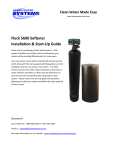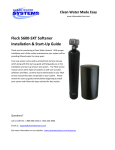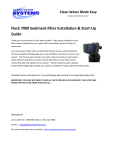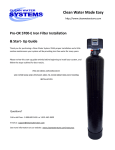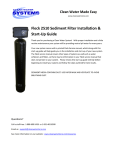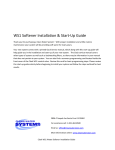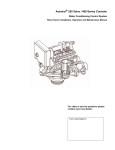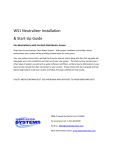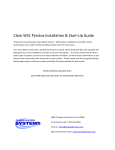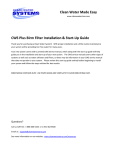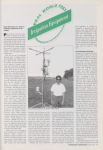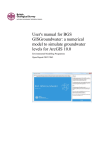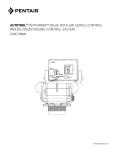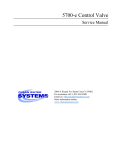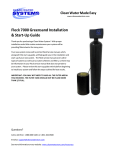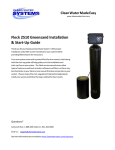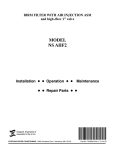Download CWS Plus Softener Installation & Start-Up Guide
Transcript
Clean Water Made Easy www.cleanwaterstore.com CWS Plus Softener Installation & Start‐Up Guide Thank you for purchasing a Clean Water System! With proper installation and a little routine maintenance your system will be providing filtered water for many years. Your new system comes with a printed Canature Service manual, which along with this start‐up guide will help guide you in the installation and start‐up of your new system. The Canature service manual covers other types of systems as well such as water softeners and filters, so there may be information in your Canature service manual that does not pertain to your system. Please review this start‐up guide entirely before beginning to install your system and follow the steps outlined for best results. Questions? Call us toll‐free: 1‐888‐600‐5426 or 1‐831‐462‐8500 Email us: [email protected] See more information on our website: www.cleanwaterstore.com/resources Clean Water Made Easy www.cleanwaterstore.com TableofContents Packing List ............................................................................................................................................................ 2 Pre‐Installation ...................................................................................................................................................... 3 Best Practices for Piping & Drain Installation ........................................................................................................ 3 How Your Softener Works ..................................................................................................................................... 4 Installation Instructions ......................................................................................................................................... 7 Attaching the brine line tubing to the brine tank & the CWS Plus brine valve ................................................... 10 Fig 8 CWS Brine Line Installation ................................................................................................................. 10 Maintaining Your CWS Plus Softener System...................................................................................................... 14 Troubleshooting the CWS Plus Softener ............................................................................................................. 15 More Troubleshooting Tips ................................................................................................................................. 17 Brine Solution Not Being Sucked In During Regeneration .............................................................................. 17 System Not Backwashing Adequately ............................................................................................................. 17 System Not Programmed Correctly – PROGRAM SETTINGS ........................................................................... 17 Brine Tank Not Filling With Enough Water ..................................................................................................... 18 CWS Plus Softener Installation & Startup Guide PackingList ModelSize:32KGrainSoftener: Quantity Description 1 CWS Plus backwash control valve & bypass valve 1 Pipe connector kit (either 1”or ¾”) 1 10” x 44” filter tank with distributor tube 1 Media funnel 2 1 cubic foot box of softening media (resin) 1 18” x 33” black brine tank ModelSize:48KGrainSoftener: Quantity Description 1 CWS Plus backwash control valve & bypass valve 1 Pipe connector kit (either 1”or ¾”) 1 10” x 54” filter tank with distributor tube 1 Media funnel 1 1 cubic foot boxes of softening media (resin) 1 ½ cubic foot box of softening media (resin) 1 18” x 33” black brine tank ModelSize:64KGrainSoftener: Quantity Description 1 CWS Plus backwash control valve & bypass valve 1 1 Pipe connector kit (either 1”or ¾”) 1 12” x 52” filter tank with distributor tube 1 Media funnel 2 1 cubic foot boxes of softening media (resin) 1 18” x 33” black brine tank ModelSize:80KGrainSoftener: Quantity Description 1 CWS Plus backwash control valve & bypass valve 1 1 Pipe connector kit (either 1”or ¾”) 1 13” x 54” filter tank with distributor tube 1 Media funnel 2 1 cubic foot boxes of softening (resin) 1 ½ cubic foot box of softening media (resin) 1 18” x 33” black brine tank *NOTE: All Fine Mesh Resin Softeners will come with a box of gravel Page 2 www.cleanwaterstore.com Rev 031114 CWS Plus Softener Installation & Startup Guide Pre‐Installation 1. Review your packing list and make sure you have received all the parts before beginning installation. Please ensure that all parts are included before scheduling a plumber or installer to come to the site. 2. If you are going to be turning off the water to the house and you have an electric water heater, shut off the power to the water heater before beginning installation in case water heater is accidentally drained. 3. Pick a suitable location for your filter system on a dry level spot where it won’t be exposed to freezing temperatures. A minimum of 20 PSI is required. Maximum pressure is 90 PSI. 4. Get all of your plumbing parts together before beginning installation. Installation typically takes 3 to 5 hours. However after installation the Softener must be allowed to run through a complete backwash and rinse cycle (also called ‘regeneration’). You don’t have to be present for this first backwash necessarily, but it does take 90 minutes. 5. After the system is installed and running, your water may be discolored, or full of sediment/rust, particularly if this is older piping that has been exposed to iron or manganese for some time. Typically this clears up over a day or two, but can persist for weeks if the pipe is old galvanized iron pipe that is corroded. BestPracticesforPiping&DrainInstallation 1. See typical installation (see Fig 2). The softener is installed after the pressure tank. 2. Make sure to connect the IN pipe to the CWS Plus inlet and the OUT to the outlet (see Fig 3). As you face the CWS Plus control from the front, the water enters on the right and exits on the left. From the back (see Fig 3) the water enters on the left and exits on the right. The inlet and outlet are attached to the bypass valve which is marked with arrows as well. 3. Make sure there is a working gate or ball valve before the CWS Plus Softener and also one after as shown in the diagram (Fig 2). The pressure gauges are optional but a hose bib (a faucet that you can attach a garden hose to) is strongly recommended after the softener and before the second ball valve. This makes it easy to rinse your new softener on start‐up and gives you a place to test the water before it enters your household plumbing. Page 3 www.cleanwaterstore.com Rev 031114 CWS Plus Softener Installation & Startup Guide 4. If you will be using copper piping, do not sweat the copper pipe directly on to the CWS Plus control valve. Avoid heating up the CWS Plus control valve plastic with the torch. 5. You do not need unions to install your CWS Plus control. If you need to remove it, the CWS Plus has quick‐release couplings that make it easy to put the softener on by‐pass and remove the filter system from the piping. 6. The drain line tubing (not supplied) is connected to a drain from the drain outlet using flexible ½” ID tubing. Note that the drain can run up above the CWS Plus control and into a drain, it does not have to drain down, as the filter backwashes under line pressure from your well pump. Most plumbing codes require an air‐gap connection, so that if your sewer or septic tank backs up, it cannot cross connect with the drain tubing. How Your Softener Works See Fig 1. In the softener, water enters the top of the tank and flows down through the media and up the distributor tube. Hardness minerals are drawn to the resin beads in the softener. During backwash, the water flow is reversed and water flows down the distributor tube and up through the media, lifting and expanding the softening media, and removing any trapped particles. After the backwash stage, salt brine is automatically drawn in from the brine tank which then slowly rinses through the softening resin for 1 hour, allowing the hardness minerals to be swapped out with harmless sodium or potassium ions. This entire automatic process, called ‘regeneration’ takes about 90 minutes. Typically the softener filter is set to regenerate every 14‐21 days, during the middle of the night when no water is being used. Fig1 Page 4 www.cleanwaterstore.com Rev 031114 CWS Plus Softener Installation & Startup Guide Fig2‐TypicalSoftenerCWSPluspipinginstallationwithballvalveandhose bibafterthefilteralongwithpre‐andpost‐filtrationifnecessary: Page 5 www.cleanwaterstore.com Rev 031114 CWS Plus Softener Installation & Startup Guide Fig3:CWSPlusfromtherearshowingtheinletandoutletend‐connector fittings1”or1‐1/4”NPTinNorylplastic.Brassend‐connectorsarealso availableforconnectingtocoppertubing. Inlet Outlet Fig4CWSPlussideview Bypass Knobs (service position) Brine Line Outlet Drain Line Page 6 Inlet www.cleanwaterstore.com Rev 031114 CWS Plus Softener Installation & Startup Guide InstallationInstructions 1. Unscrew by hand the entire CWS Plus control valve from top of tank if it was shipped screwed on. Place distributor tube in tank if not already inside tank. If not already done, make sure blue cap is on top of distributor tube, or wrap the top of distributor tube with electrical or duct tape. The idea is we do not want any media to go down the distributor tube. Plug or tape top of distributor tube when adding media to prevent media from entering. Remove when finished. 2. Next add the softening resin using the media funnel provided. Tank will be approximately 2/3to the 3/4 full. NOTE: If you are using a softener with fine mesh resin, you will want to first add the gravel provided before adding resin 3. Remove cap or tape from top of distributor tube. Be careful not to pull up distributor tube when removing cap or tape. 4. Attach plastic top screen to the under‐side of the CWS Plus control valve. It is a funnel‐shaped plastic screen that snaps on to the control valve and prevents resin from being backwashed out to drain during the regeneration cycles. Page 7 www.cleanwaterstore.com Rev 031114 CWS Plus Softener Installation & Startup Guide 5. NOTE Regarding Teflon tape and pipe sealants: It is OK to use Teflon tape and pipe sealant on the water pipe connector threads, where you attach your pipes or plumbing to the CWS Plus. DO NOT USE any Teflon tape or pipe joint compound on the tank itself or on the threads where the CWS Plus threads into the tank. 6. Install the CWS Plus backwash control‐timer valve on to the top of the filter tank by hand, do not over‐tighten. Tighten with hands, there is no need for a pipe wrench or other wrench. 7. See the bypass image below. Note that Items 2 are the pipe connectors and the other end is what gets attached to the control valve. Items 3 are the red clips that hold the pipe connectors to the by‐ pass valve. To put system on or off bypass do NOT remove the red clips. Just turn knobs (1). The CWS Plus valve is usually shipped in by‐pass position. Leave in bypass position for now. CWSPlusBy‐Pass(1)&PipeConnectors(2) 1 ‐ Bypass Knobs (service position) 3 3 2 Page 8 www.cleanwaterstore.com Rev 031114 CWS Plus Softener Installation & Startup Guide 8. Lubricate the by‐pass valve o‐rings on the pipe connectors only with some vegetable oil or silicone grease and connect the bypass assembly to the CWS Plus control by sliding the bypass valve firmly into the body of the CWS Plus. Once the bypass valve is in far enough, you will be able to easily insert the red connector clips. DO NOT USE OIL OR PETROLEUM GREASE ON ANY PART OF THE CWS PLUS CONTROL VALVE. O‐rings are OK to lubricate but not the main tank threads. 9. Make sure the by‐pass valve is in the bypass position (above) when starting the installation. Follow the IN and OUT arrows on the bypass valve and control valve for proper connection of water piping. Leave in the BY‐PASS position for now. 10. Now install your water pipes to the CWS Plus bypass end connectors. Our preferred method is to wrap the pipe threads with 2 or 3 wraps of Teflon tape, then apply a thin coating of white non‐ hardening Teflon joint compound paste (available at all hardware stores) before attaching the pipe fittings. Make sure the inlet is installed to the 'In" pipe connector on the bypass valve and outlet is on the “Out” connector. Note: Arrows on bypass valve should be visible from the top of the bypass valve. 11. Connect some flexible tubing from the drain connection on the CWS Plus control valve to a suitable drain such as a septic tank or drain to a sewer. It is OK to run the drain line up and over the Softener, up to 4 feet above the top of the tank. If the drain line will be more than 20 feet, and especially if your system is a 2.0 or 2.5 cubic foot size, use larger diameter tubing such as ¾” or 1”. Note that it is desirable to be able to run the drain line into a bucket in order to test the backwash flow rate in the future. This is why hard piping the drain line is discouraged, however, if you do use hard PVC piping for the drain line, and you are able to remove the hard PVC drain piping and attach flexible tubing should you ever desire for testing purposes, it is OK to use rigid PVC pipe for the drain. Make sure the drain tubing is firmly clamped to the barbed fitting with a hose clamp to prevent leaks. 12. Next, connect the solution tank to the CWS Plus control valve with the black tubing, provided with the brine tank. Page 9 www.cleanwaterstore.com Rev 031114 CWS Plus Softener Installation & Startup Guide Attaching the brine line tubing to the brine tank & the CWS Plus brine valve 13. Insert 3/8” diameter tubing into the brine tank connection. Simply push the tubing into the fitting until it can go no further; the tube should be snug in the fitting (Fig 8A). If you need to remove the tubing, hold the flanged ends of the tube insert against the fitting and firmly pull the tubing out (Fig 8B); simply pulling on the tubing can damage the fitting. Fig8CWSBrineLineInstallation A. ✔ B. X Page 10 www.cleanwaterstore.com Rev 031114 CWS Plus Softener Installation & Startup Guide 14. To connect the brine tank, begin by sliding the plastic brine injector nut on to the brine tubing by putting the tubing through the non‐threaded side of the nut. Next, slide the black (or clear) compression ring on to the tubing with the narrower diameter going on first. Then slide the taller, white compression ring on to the tubing with the wider diameter going on first. The two compression rings should lay flush against each other on the tubing. Slide them in to the brine injector nut and place the brine tubing into the brine valve. Finally, push the brine injector nut, which now has the compression rings inside of it, on to the threading of the brine valve and rotate the nut clockwise, screwing it on to the brine valve. Tighten it down to finger tightness. The tubing should be firmly attached and not slide out if pulled on. 15. Add approximately 5 gallons of water to the brine tank, and then fill the brine tank with salt, using about 300 lbs, or 6 50‐lb bags. It is OK to use any kind of water softening salt, however we find that extra coarse salt works better than pellets. You do not have to add water to the brine tank again after this first time during the start‐up. 16. See the over‐flow barbed fitting on the side of the brine tank. You do not have to connect this to a drain. If the safety float were to malfunction, there is a small chance that the brine solution will drip out of this fitting. If this would cause a big mess where you have installed the softener, hook some tubing to this and run to a bucket, floor pan or floor drain. Normally no brine will leak out of this fitting. 17. Now you are ready to turn on the water to the system. Turn on the water and leave on bypass and check for leaks. Leave the ball valve after the softener closed, so water is still off to the house, but connect a garden hose and open up the hose bib after the softener and allow the water to run. This will help to clear out any foreign material that may be in the pipes from the piping installation. If you do not have a valve installed after the softener and you do not have a hose bib, you will need to turn the water on inside the house to let the water run. Use a bathtub or laundry sink or other fixture that does not have an aerator screen. 18. Leave the water running out of the garden hose at a slow rate. Now you can turn the bypass valve to the service position. You do NOT remove the red clips on the bypass knobs in order to turn the bypass valves from the bypass to the service position. First open the Inlet Side of the bypass valve. Second slowly open the Outlet Side of the bypass until it is in the full service position. The CWS Plus bypass valve knobs are a little stiff, so you can use a screw driver placed in the holes to turn the Page 11 www.cleanwaterstore.com Rev 031114 CWS Plus Softener Installation & Startup Guide knobs. Make sure you are turning the bypass valve knobs in the correct direction which is counter‐ clockwise as you face the bypass valve knobs. 19. Now turn on the garden hose to full force and let the water until it turns relatively clear. The water may have some color at first. 20. You are now ready to plug in your Softener CWS Plus control valve and start programming. Your valve does require some modifications to the programming specific to your application. 21. Plug your CWS Plus control valve into an outlet. After being plugged in, the screen may display “WAITING PLEASE” while it finds the service position. Next you will need to program the system to work as a Greensand Filter. There are a few settings that must be changed before the system can be put into service. 22. PROGRAMMING: a. First, press the menu button labeled once. If it says “SCREEN LOCKED,” you may have to press and hold the upper left button labeled unlock the display screen. about 3 seconds until a beep sounds to b. NOTE: Use the up and down arrows to cycle through the various program settings. To change any setting, press ‘ ’. When the display flashes, the value may be changed. Press either the up or down arrow to change the value. Press ‘ ’ once more to accept the value, and the display should stop flashing to indicate that the setting has been saved. c. Step 1: REGIONAL US GAL (this stands for US gallons format, if it is different, change it to US GAL). When it is set, press the down button to proceed to the next step. d. Step 2: The display should be set to: “METER OVERRIDE”. By default, the system is most likely set to “METER IMMEDIATE” or “METER DELAYED.” We recommend METER OVERRIDE for the operation of your softener, to backwash by gallons, but also with a day limit. Change the setting, then press the down arrow to proceed to the next step. e. Step 3: TIME‐ set the time of day. Press the down button to proceed. f. Step 4: REG. TIME ‐ Set to 2:00 AM generally or sometime when no water is being used, and no other filter or softener is likely to be in a regeneration cycle. Then press the down button. g. Step 5: REG. DAYS ‐ This tells the softener to regenerate after a certain number of days if the gallon limit is not reached. It can be set for any setting between 1‐99 days, however we recommend 14 days for it to backwash at least every two weeks. Then press the down button. h. Step 6: REG. CAP – This is the gallon limit set for how often the softener will regenerate. This number is based on your hardness, capacity of water softener and usage. You can refer to the table on page 14 of the included manual to select the recommended gallon setting. Page 12 www.cleanwaterstore.com Rev 031114 CWS Plus Softener Installation & Startup Guide i. Step 6: BACKWASH ‐ Stands for Backwash length in minutes. It should be set to 10 MIN which means 10 minutes of backwash. Press the down button one time. j. Step 7: BRINE ‐ stands for Brine Draw. This is the cycle where solution is sucked in from the potassium permanganate solution tank. This cycle is 60 minutes long and should display: 60 MIN. Press the down button one time. k. Step 8: RINSE ‐ This is the Rapid Rinse cycle and should display: 10 MIN. Press the down button one more time. l. Step 9: REFILL ‐ This is the Brine Fill, where the water is added to the brine tank to make solution for the next cycle. This should display: For 32K grain softeners set to 12.0 MIN; 48K grain softeners set to 20.0 MIN; 64K grain softeners set to 26.0 MIN; 80K grain softeners set to 32.0 MIN. Press the down button one time. m. Programming is finished‐ to exit, press the upper menu button to Service mode. one more time to return 23. Now you can start the initial manual backwash. This will regenerate the softening resin, which is required before using your treated water. Turn the manual knob clockwise to “BA. WA” and a manual backwash will begin. 24. Very slowly turn the Inlet knob on the bypass valve towards the service position, but DO NOT open the valve all the way. We want to allow all of the air in the tank to escape before allowing the water to flow freely. Keep the Outlet knob in bypass. The bypass valve knobs may be a little stiff at first. 25. At this point the softener will be in a backwash mode, which is the first of five cycles it goes through during regeneration. The backwash takes 8 minutes. After 8 minutes, the CWS Plus will begin to suck up the brine solution from the brine tank. 26. After another 10 to 15 minutes the brine tank will be sucked dry of the salt brine. Check to make sure that the brine tank has no water after this cycle. 27. After 60 minutes of being in this Cycle 2, referred to as the brining cycle, it will move to the next cycle, Cycle 3, which is a 6 minute second backwash cycle. The next cycle, Cycle 4 is a 10 minute rapid rinse. Finally Cycle 5 refills the brine tank. 28. Check to make sure at the end of the cycles that the brine tank is filled with enough water to cover salt. You can change the level of the brine by adjusting the level of the float assembly. For most users though it is not necessary to adjust the float, it comes set to the correct level. 29. After the regeneration process is complete, turn on the water to the house and run the water in the house for a few minutes. 30. Refer to your Canature 165 service manual for more information about how your control valve is programmed if desired. Page 13 www.cleanwaterstore.com Rev 031114 CWS Plus Softener Installation & Startup Guide Maintaining Your CWS Plus Softener System Adding Salt to the Brine Tank: Be sure to check the level of salt every few months (typically 3‐4 months). You will see that the salt level will drop after a certain period of time based on your usage, at which point you will want to add more salt as you did the first time. Clean the Injector Once a year, clean the brine tank and the brine injector. 1. Shut off water to filter or put filter on bypass. 2. Release water pressure by turning the center knob on the timer assembly by a few degrees clockwise. 3. Unplug the control valve from the electrical outlet. 4. Unscrew the bolts near the brine line fitting using a small screw driver. Using this small screwdriver, remove the injector nozzle and throat, unscrewing counter‐clockwise. You may need to use a paper clip or other piece of wire to remove the lower nozzle once it is unscrewed. 5. Replace and/or clean parts the throat and nozzle in muriatic acid or vinegar. 6. Put the system back in service and plug in the control valve. Make sure the timer assembly is advanced so the piston is in the service position. If you are not sure, wait two hours until the timer assembly does this automatically. 7. Next clean the potassium perm tank by removing the felt pad and cleaning in muriatic acid, citric acid or vinegar, or better yet just replacing the felt pad if you want. Clean the float and rinse the pot perm tank out. It’s better to use rubber gloves when you are doing this to avoid the possibility of staining Page 14 www.cleanwaterstore.com Rev 031114 CWS Plus Softener Installation & Startup Guide your hands with potassium permanganate. If your hands do become stained you can clean them with vinegar or lemon juice. Troubleshooting the CWS Plus Softener PROBLEM / SYMPTOM POSSIBLE CAUSE Water softener fails to regenerate Hard water Electrical service to unit has been interrupted Assure permanent electrical service (check fuse, plug, pull chain, or switch) Timer is defective Replace timer Power failure Reset time of day By‐pass valve is open Close by‐pass valve. No salt is in brine tank Unit used too much salt Loss of water pressure Injector screen plugged. Add salt to brine tank and maintain salt level above water level. Clean injector screen Insufficient water flowing into brine tank. Check brine tank fill time and clean brine line flow control if plugged Hot water tank hardness. Repeated flushings of the hot water tank is required. Leak at distributor tube. Internal valve leak Make sure distributor tube is not cracked. Check O‐ring and tube pilot. Replace seals and spacers and/or piston. Improper salt setting. Check salt usage and salt setting Excessive water in brine tank. See problem 7. Iron buildup in line to water conditioner Clean line to water conditioner. Iron buildup in water conditioner. Clean control and add mineral cleaner to mineral bed. Increase frequency of regeneration. Remove piston and clean control Inlet of control plugged due to foreign material Page 15 SOLUTION www.cleanwaterstore.com Rev 031114 CWS Plus Softener Installation & Startup Guide Loss of softening resin through drain line broken loose from pipes by recent work done on plumbing system. Air in water system Iron in conditioned water Improperly sized drain line flow control. Fouled mineral bed. Excessive water in brine tank Softener fails to draw brine Control cycles continuously Drain flows continuously Plugged drain line flow control Assure that well system has proper air eliminator control. Check for dry well condition. Check for proper drain rate. Check backwash, brine draw, and brine tank fill. Increase frequency of regeneration. Increase backwash time. Clean flow control Plugged injector system Clean injector and screen. Timer not cycling Replace timer Foreign material in brine valve Replace brine valve seat and clean valve. Foreign material in brine line flow control. Drain line flow control is plugged Injector is plugged. Clean brine line flow control Injector screen plugged Clean screen Line pressure is too low Increase line pressure to 20 psi (1.3 bar) Internal control leak Change seals, spacers, and piston assembly. Service adapter did not cycle. Check drive motor and switches. Misadjusted, broken, or shorted switch Valve is not programming correctly. Determine if switch or timer is faulty and replace it, or replace complete power head. Check timer program and positioning of control. Replace power head assembly if not positioning properly. Remove power head assembly and inspect bore. Remove foreign material and check control in various regeneration positions Foreign material in control. Internal control leak. Clean drain line flow control Clean injector Replace seals and piston assembly. Page 16 www.cleanwaterstore.com Rev 031114 CWS Plus Softener Installation & Startup Guide More Troubleshooting Tips Brine Solution Not Being Sucked In During Regeneration Most problems occur when the CWS Plus is not drawing in the brine. Make sure the injector is drawing in the brine: 1. Remove the brine tank tubing where it enters the CWS Plus control valve. 2. Turn the knob on the front of the CWS Plus valve to the “BA. WA.” position until a backwash is started. After the display stops blinking and it is in a backwash cycle, press the ‘ ’button again, and it will advance to the next cycle, which is the Brine Cycle, where it is supposed to suck in the brine solution. 3. If it is sucking strongly, check the brine tank float inside the brine well and make sure there are no rubber bands around it, and that is free of obstructions. In some cases it may need to be replaced or cleaned, if there is suction at the control valve, but no brine is being drawn in. 4. If there is NO suction at the control valve port where you removed the brine line tubing, then the injector should be cleaned. 5. If the injector has been cleaned and there is still no suction check to make sure there is obstruction in the backwash line; that the backwash line does not go up and over the softener more than several feet (which causes pressure loss and the injector not to work correctly); finally check to make sure there is enough pressure. If possible increase your water pressure to softener from your well pump and see if a slightly increased pressure makes the injector work. We recommend a minimum 30 PSI but it does work better if there is 40 to 50 minimum PSI. System Not Backwashing Adequately The other second main problem that may occur is if you do not have enough backwash flow rate to properly clean the water softener. You can verify the backwash flow rate by running the drain line into a bucket and timing it when the CWS Plus is in Cycle 1 or backwash. A 1.0 or 1.5 cubic foot system should have 2.0 gallons per minute and a 2.5 cubic foot system should have 4.0 gallons per minute of backwash. System Not Programmed Correctly – PROGRAM SETTINGS In some cases, the CWS Plus may not be programmed correctly. Verify the correct programming by following the step 22 earlier in the start‐up guide. Page 17 www.cleanwaterstore.com Rev 031114 CWS Plus Softener Installation & Startup Guide Brine Tank Not Filling With Enough Water Sometimes if the brine tank is not filling adequately, it is possible that the float assembly in the tank is set too low. You would want the float to be several inches above the air check valve inside the tank. This will allow for enough water to be added to the tank before shutting the brine fill cycle. If necessary, pull the float assembly rod up to the appropriate height, and cut the rod at that height, leaving while keeping the rubber washers the adequate space to hold the float in place. Page 18 www.cleanwaterstore.com Rev 031114




















